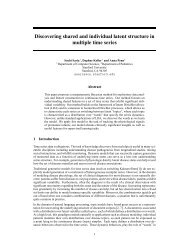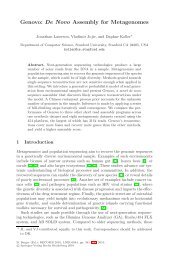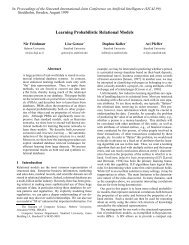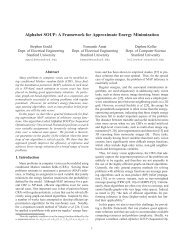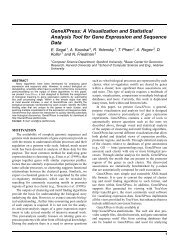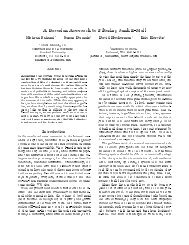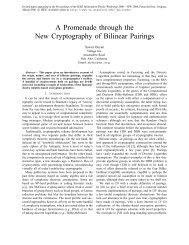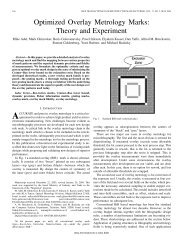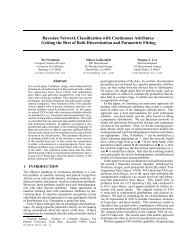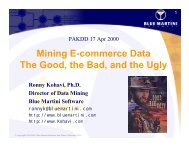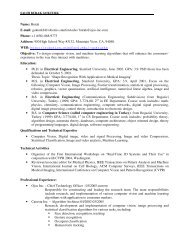Region-based Segmentation and Object Detection - Stanford ...
Region-based Segmentation and Object Detection - Stanford ...
Region-based Segmentation and Object Detection - Stanford ...
You also want an ePaper? Increase the reach of your titles
YUMPU automatically turns print PDFs into web optimized ePapers that Google loves.
encoding such relationships through pairwise energy terms between objects Co <strong>and</strong> regions Sr. We<br />
do not encode contextual relationships between region classes (i.e., Sr <strong>and</strong> Ss) since these rarely<br />
help. 2 Contextual relationships between foreground objects (i.e., Co <strong>and</strong> Cm) may be beneficial<br />
(e.g., people found on bicycles), but are not considered in this work. Formally, the context term is<br />
ψ ctxt<br />
or (Co,Sr) = −η ctxt log σ Co × Sr | φor;θ ctxt<br />
(5)<br />
where φor : (Po, Pr, I) ↦→ Rn is a pairwise feature vector for object o <strong>and</strong> region r, σ(·) is the<br />
multi-class logit, <strong>and</strong> ηctxt weights the strength of the context term relative to other terms in the<br />
energy function. Since the pairwise context term is between objects <strong>and</strong> (background) regions it<br />
grows linearly with the number of object classes. This has a distinct advantage over approaches<br />
which include a pairwise term between all classes resulting in quadratic growth.<br />
3.2 <strong>Object</strong> Detectors<br />
Performing well at object detection requires more than simple region appearance features. Indeed,<br />
the power of state-of-the-art object detectors is their ability to model localized appearance <strong>and</strong> general<br />
shape characteristics of an object class. Thus, in addition to raw appearance features, we append<br />
to our object feature vector φo features derived from such object detection models. We discuss two<br />
methods for adapting state-of-the-art object detector technologies for this purpose.<br />
In the first approach, we treat the object detector as a black-box that returns a score per (rectangular)<br />
c<strong>and</strong>idate window. However, recall that an object in our model is defined by a contiguous<br />
set of pixels Po, not a rectangular window. In the black-box approach, we naively place a bounding<br />
box (at the correct aspect ratio) around these pixels <strong>and</strong> classify the entire contents of the box. To<br />
make classification more robust we search c<strong>and</strong>idate windows in a small neighborhood (defined over<br />
scale <strong>and</strong> position) around this bounding box, <strong>and</strong> take as our feature the output of highest scoring<br />
window. In our experiments we test this approach using the HOG detector of Dalal <strong>and</strong> Triggs [4]<br />
which learns a linear SVM classifier over feature vectors constructed by computing histograms of<br />
gradient orientations in fixed-size overlapping cells within the c<strong>and</strong>idate window.<br />
Note that in the above black-box approach many of the pixels within the bounding box are not<br />
actually part of the object (consider, for example, an L-shaped region). A better approach is to<br />
mask out all pixels not belonging to the the object. In our implementation, we use a soft mask that<br />
attenuates the intensity of pixels outside the object <strong>based</strong> on their distance to the object boundary (see<br />
Figure 2). This has the dual advantage of preventing hard edge artifacts <strong>and</strong> being less sensitive to<br />
segmentation errors. The masked window is used at both training <strong>and</strong> test time. In our experiments<br />
we test this more integrated approach using the patch-<strong>based</strong> features of Torralba et al. [19, 20].<br />
Here features are extracted by matching small rectangular patches at various locations within the<br />
masked window <strong>and</strong> combining these weak responses using boosting. <strong>Object</strong> appearance <strong>and</strong> shape<br />
are captured by operating on both the original (intensity) image <strong>and</strong> the edge-filtered image.<br />
For both approaches, we append the score (for each object) from the object detection classifiers—<br />
linear SVM or boosted decision trees—to the object feature vector φo.<br />
(a) full window (b) hard region mask (c) hard window (d) soft region mask (e) soft window<br />
Figure 2: Illustration of soft mask for proposed object regions.<br />
An important parameter for sliding-window detectors is the base scale at which features are extracted.<br />
Scale-invariance is achieved by successively down-sampling the image. Below the basescale,<br />
feature matching becomes inaccurate, so most detectors will only find objects above some<br />
minimum size. Clearly there exists a trade-off between the desire to detect small objects, feature<br />
quality, <strong>and</strong> computational cost. To reduce the computational burden of running our model on<br />
high-resolution images while still being able to identify small objects, we employ a multi-scale approach.<br />
Here we run our scene decomposition algorithm on a low-resolution (320 × 240) version<br />
of the scene, but extract features from the original high-resolution version. That is, when we extract<br />
object-detector features we map the object pixels Po onto the original image <strong>and</strong> extract our features<br />
at the higher resolution.<br />
2 The most informative region-to-region relationship is that sky tends to be above ground (road, grass, or<br />
water). This information is already captured by including the horizon in our region term.<br />
5




